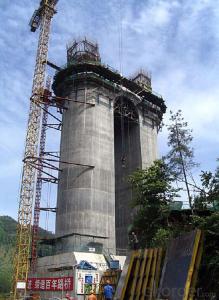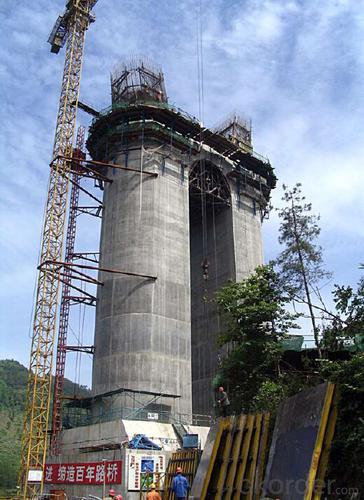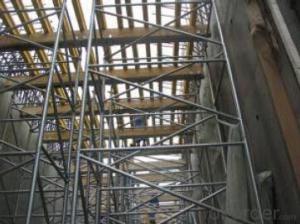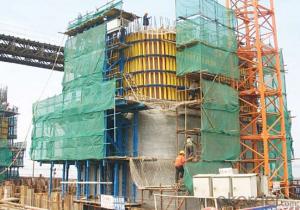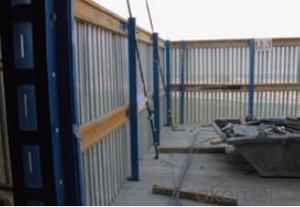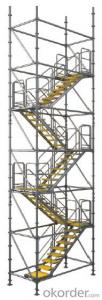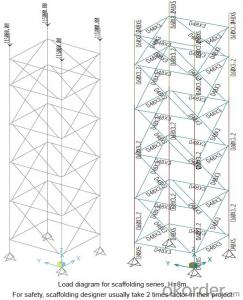Auto Climbing Bracket ACB-100 & ACB-50 for formwork and scaffolding system
- Loading Port:
- Tianjin
- Payment Terms:
- TT OR LC
- Min Order Qty:
- 50 m²
- Supply Capability:
- 1000 m²/month
OKorder Service Pledge
OKorder Financial Service
You Might Also Like
Auto-climbing Bracket ACB100 & ACB50
The power of the auto-climbing formwork is the hydraulic system, which includes the oil cylinder
and two commutators. The commutators can control the climbing of climbing rail and the bracket.
The steel rail and the bracket can inter-climbing, so the whole system will climb up steadily.
Cranes are not needed during the construction. It’s easy to operate, highly efficient and safe. It’s
the best choice for the construction of high buildings and bridges.
There are mainly two types of standard auto-climbing brackets, ACB-50 and ACB-100, the figure
means the push power of cylinder with unit of KN.
Characteristics:
◆ Perfect load bearing anchor system
Anchor system is the most important supporting part. The system is made of five parts shown
below. Thereinto, tensile bolt, V-climbing cone and washer can be taken out for reusing after the
concrete pouring finished.There are two kinds of anchor systems,A & B. A is matched with single
anchor shoe and B is matched with double anchor shoe.
◆ Crane-independent
Crane-independent forming, striking and climbing speeds up the work procedures on the
construction site and also makes them independent of each other. This means the planned
sequences can be maintained along with guaranteeing high productivity levels. The crane can
therefore be used for other tasks.
Hydraulic system is mainly made of two commutators,
oil cylinder and power distribution system.The
commutators can control the climbing of climbing rail
and bracket.
◆ High bearing capacity and safe
The stable working platforms are able to carry large loads, e.g. the storage of reinforcing steel
for the next climbing section. Generously-sized working platforms, the well thought-out design for
handling very high wind loads and the patented control function of the climbing mechanism are
some of the special details contained within the comprehensive safety concept.
◆ Platforms adjusted to suit the angle of inclination
The horizontal working areas thus created provide safe and comfortable conditions for
reinforcement work, shuttering and striking, concreting and finishing.
◆ The ACB formwork system can climb not only vertically but also slantways, the largest angle is
18 degrees.
◆ The system can climb up wholly or separately. The climbing process is steady, synchronous
and safe.
◆ The bracket will not fall to the ground until the construction is finished, the field will be saved
and the impacting breakage will be reduced (especially the panel).
◆ The system will furnish omnidirectional platform, the construction organizations don’t need to
set up additional operation platform.
◆ The error of structure construction is small and easy to correct.
◆ The climbing speed is fast, the construction course will be quickened.
◆ The formwork can climb itself and cleaning work can be done in the same situs , the used times
of tower crane will be greatly reduced.
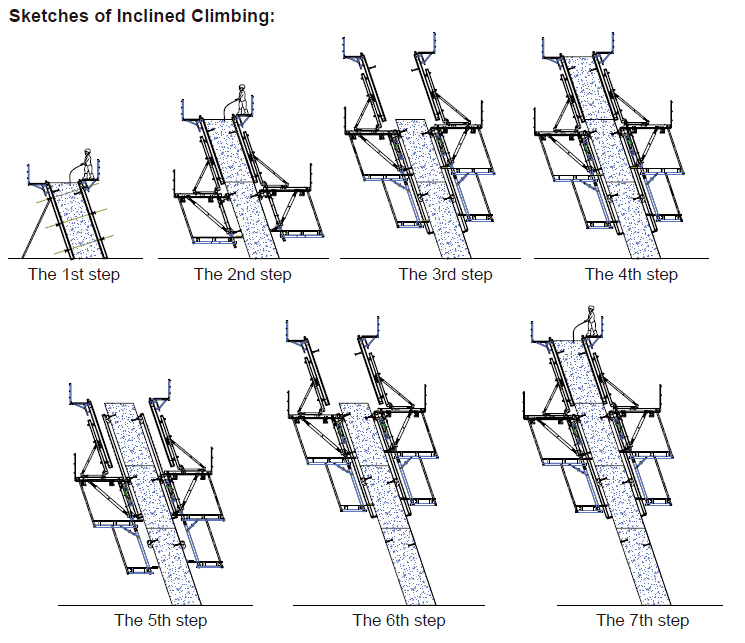
- Q: Can steel formwork be used for architectural concrete finishes?
- Yes, steel formwork can be used for architectural concrete finishes. Steel formwork offers a number of advantages that make it suitable for creating high-quality architectural finishes. Firstly, steel formwork provides excellent dimensional accuracy and stability, ensuring that the concrete is poured and cured in the desired shape and size. This allows for precise and intricate architectural detailing. Furthermore, steel formwork is highly durable and can withstand the pressure and weight of the concrete during the pouring and curing process. This durability ensures that the formwork remains intact and does not deform or warp, resulting in a smooth and even concrete finish. Steel formwork also allows for easy demolding, as it can be easily dismantled without damaging the concrete structure. This makes it convenient for achieving architectural finishes that require complex shapes or multiple components. In addition, steel formwork can be easily reused, making it a cost-effective option for architectural projects. It can withstand multiple uses, reducing the need for frequent replacements and saving both time and money. However, it is important to note that the choice of formwork material depends on the specific requirements of the architectural concrete finish. While steel formwork is suitable for most applications, there may be instances where other materials such as wood or plastic formwork are more appropriate. Consulting with a structural engineer or a construction professional can help determine the most suitable formwork material for a particular architectural concrete finish.
- Q: What are the different types of accessories used with steel formwork?
- Some different types of accessories used with steel formwork include wedges, clamps, connectors, form ties, formwork braces, pins, and formwork release agents.
- Q: Can steel formwork be used for concrete structures in corrosive environments?
- No, steel formwork should not be used for concrete structures in corrosive environments as it may lead to corrosion of the steel and compromise the integrity of the structure.
- Q: Are there any environmental benefits to using steel formwork?
- Yes, there are several environmental benefits to using steel formwork in construction projects. Firstly, steel formwork is highly durable and can be reused multiple times, reducing the need for new formwork materials. This significantly reduces the amount of waste generated during construction, as traditional formwork materials like timber are often discarded after a single use. By using steel formwork, construction companies can minimize their environmental footprint by reducing the amount of waste sent to landfills. Additionally, steel formwork is recyclable, meaning that at the end of its lifecycle, it can be recycled and repurposed into new steel products. This helps to conserve natural resources and reduce the demand for raw materials. Furthermore, the energy required to recycle steel is significantly less than the energy required to produce new steel, resulting in reduced greenhouse gas emissions. Steel formwork also offers advantages in terms of energy efficiency. Compared to traditional formwork materials, steel formwork requires less energy to manufacture and transport, resulting in lower carbon emissions. Furthermore, steel formwork is known for its high strength and rigidity, which allows for the construction of more slender and lightweight structures. This can lead to reduced material consumption and subsequently lower energy requirements for heating, cooling, and lighting in the constructed buildings. Lastly, steel formwork is resistant to moisture, fire, and pests, reducing the need for chemical treatments and preservatives that can harm the environment. This makes steel formwork a more sustainable option and reduces the negative impact on ecosystems and human health. Overall, the use of steel formwork in construction projects offers several environmental benefits, including reduced waste generation, increased recycling opportunities, energy efficiency, and reduced reliance on harmful chemicals. By choosing steel formwork, construction companies can contribute to a more sustainable and environmentally-friendly construction industry.
- Q: How does steel formwork handle concrete shrinkage and expansion?
- Steel formwork handles concrete shrinkage and expansion by providing a rigid framework that supports and contains the concrete during the curing process. The steel formwork is designed to withstand the pressure exerted by the concrete, preventing any deformation or cracking that may occur due to shrinkage or expansion. Its strength and durability ensure that the formwork remains intact and stable, effectively managing the dimensional changes of the concrete.
- Q: Can steel formwork be used for projects with limited formwork stripping time?
- Projects with limited formwork stripping time can utilize steel formwork. Steel formwork is renowned for its durability and strength, rendering it suitable for diverse construction ventures. Unlike traditional formwork materials like wood or plywood, steel formwork can withstand higher pressures and loadings, enabling faster construction cycles. High-rise buildings, bridges, and infrastructure projects often employ steel formwork due to its time-sensitive nature. Its inflexible structure facilitates swift assembly and disassembly, minimizing formwork stripping time. Moreover, steel formwork can be reused multiple times, further diminishing construction time and expenses. Additionally, steel formwork guarantees precise dimensional control, ensuring accurate and consistent outcomes. This quality holds particular significance for projects with limited formwork stripping time since any errors or discrepancies in the formwork can result in delays and additional work. Nevertheless, it is essential to acknowledge that installing and removing steel formwork may require skilled labor and specialized equipment. Hence, meticulous planning and coordination are imperative to ensure efficient and safe utilization of steel formwork for projects with limited formwork stripping time.
- Q: What are the typical lifespan and durability of steel formwork systems?
- The typical lifespan of steel formwork systems can vary depending on various factors such as maintenance, usage, and environmental conditions. However, with proper care and maintenance, steel formwork systems can have a lifespan of several years or even decades. In terms of durability, steel formwork systems are known for their high strength and resistance to wear and tear, making them a reliable and long-lasting option for construction projects.
- Q: How does steel formwork contribute to the fire resistance of the structure?
- Steel formwork does not directly contribute to the fire resistance of a structure. Its main purpose is to provide temporary support during the construction process. However, steel formwork can indirectly contribute to fire resistance by ensuring the proper placement and alignment of concrete, which is a fire-resistant material. The correct installation of concrete using steel formwork can help create a structurally sound and fire-resistant building.
- Q: Can steel formwork be used for hospital construction projects?
- Yes, steel formwork can be used for hospital construction projects. Steel formwork is a versatile and durable construction material that offers several advantages for hospital projects. It provides excellent strength and stability, which is crucial for ensuring the safety and integrity of the building. Steel formwork also allows for efficient and precise construction, as it can be easily assembled and disassembled, and its modular nature allows for flexibility in design and layout changes. Additionally, steel formwork has a smooth surface finish, which is important for maintaining a hygienic environment in a hospital setting. It is also resistant to moisture and chemicals, making it suitable for areas that require frequent cleaning and sterilization. Overall, steel formwork is a reliable and suitable choice for hospital construction projects.
- Q: Can steel formwork be used for both interior and exterior concrete elements?
- Steel formwork is suitable for both interior and exterior concrete elements. Its versatility makes it applicable to different construction projects. Furthermore, steel formwork is known for its durability, strength, and ability to withstand the pressure exerted by wet concrete. It also provides exceptional dimensional accuracy and ensures smooth and uniform concrete surfaces. Whether constructing interior slabs, walls, or exterior foundations, columns, or beams, steel formwork is a dependable option for both interior and exterior concrete elements.
Send your message to us
Auto Climbing Bracket ACB-100 & ACB-50 for formwork and scaffolding system
- Loading Port:
- Tianjin
- Payment Terms:
- TT OR LC
- Min Order Qty:
- 50 m²
- Supply Capability:
- 1000 m²/month
OKorder Service Pledge
OKorder Financial Service
Similar products
Hot products
Hot Searches
